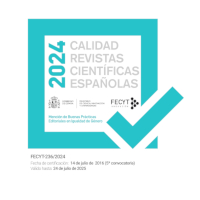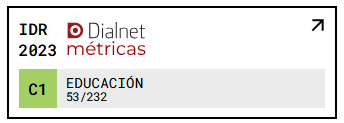Sistemas de representación de números racionales positivos : Un estudio con maestros en formación
DOI:
https://doi.org/10.18172/con.490Abstract
This survey is structured into two stages differentiated by the aims and methodology used in its realization. The first stage in mainly based on a didactic assignment, done by applying Research- Action methodology and intended to be performed by a group of students studying to be Teachers of Primary Education in the University of Zaragoza. This assignment aims at increasing future teachers' comprehension of positive rational numbers through implementing the links existing between fractional and decimal notations. In order to achieve this objetive, a pattern with two systems of representation of amounts not whole of magnitude is defined, through which fractional and decimal expressions are conceptualized as results of equalitarian distributions, revealing that fractional and decimal notations admit a similar underlying structure. In the second stage, the methodology of interview is used with three students who took part in the first satage. The aim is to study the relations between these students' previous productions and their performance as teachers who have to correct schoolchildren's tasks. As a result, it can be inferred that the greater the future teachers' comprehension of the pattern is, the more effective they prove to be in detecting and analysing children's errors, and the more sustained reasons they offer in the physical world; on the other hand, the future teachers who have not understood clearly the pattern tend to consider schoolchildren's errors as correct and to give priority to the symbolic language used by the children in their explanations.Downloads
References
Abraira, C. F. y Francisco, M. A. (Coords.), (1997). II Simposio.El curriculum en la formación inicial de los profesores de Primaria en el Area de Matemáticas. León: Facultad de Educación.
Arnal, J., Rincón, D. del y Latorre, A. (1992). Investigación educativa. Fundamentos y metodología. Barcelona: Labor.
Benoit, P., Chemla, K y Ritter, J. (Eds.) (1992). Histoire de fractions, fractions d'historie. Berlin: Birkhäusen Verlag.
Blanco, L. y Cruz, M. C. (Coords.), (1997). Aportaciones al curriculum en la formación inicial de los profesores de Primaria en el Area de Matemáticas. I.C.E., Universidad de Leon.
Boyd, B. (1992). The relationship between mathematics subject matter knowledge and instruction: a case study. (Tesis no publicada). California: San Diego State University.
Brousseau, G. y Brousseau, N. (1987). Rationnels et décimaux dans la scolarité obligatorie. I.R.E.M. de Bordeaux I.
Caldwell, J. H. (1995). Communicating About Fractions with Pattern Blocks. Teaching Children Mathematics, 2(3): 156-161.
Carpenter, T. P.; Fennema, E. y Romberg, T. A. (Eds.) (1993). Rational Numbers. An Integration of Research. New Jersey: Lawrence Erlbaum Associates Publishers.
Casell, C. y Symon G. (Eds.) (1994). Qualitative methods in organizacional research. Londres: Sage.
Castro, E. (1994). Exploración de Patrones Numéricos mediante Configuraciones Puntuales. Estudio con escolares de Primer Ciclo de Secundaria (12-14 años). Tesis Doctoral, Universidad de Granada.
Castro, E., Rico, L. y Romero, I. (1997). Sistemas de representación y aprendizaje de estructuras numéricas. Enseñanza de las Ciencias, 15(3), 361-371.
Centeno, J. (1988). Números decimales ¿Por qué? ¿Para qué? Madrid: Síntesis.
Chapell, M. F. y Thompson, D. R. (1994). Modeling the NCTM Standars: Ideas for Initial Teacher Preparation Programs. En Aichele, D. B. y Coxford, A. F., Professional Development for Teachers of Mathematics. Reston (Virginia): N. C.T.M., pp. 186-199.
Cohen, L. y Manion, L. (1990). Métodos de investigación educativa. Madrid: La Muralla.
Denzin, N. y Lincoln, Y. (Ed.). (1994). Handbook of Qualitative Research. California: Sage Publications.
Duval, R. (1995). Semiosis et pensée humaine. Berna: Peter Lang.
Elliot, J. (1990). La Investigación-Acción en Educación. Madrid: Morata.
Feferman (1989). The number systems. Foundations of Algebra and Analysis. New York: Chelsea Publishing Company.
Flores, P. (1996). Creencias y concepciones de los futuros profesores sobre las matemáticas, su enseñanza y su aprendizaje. Uno, revista de didáctica de las matemáticas, 8: 103-111.
Gairín, J. (1987). Las actitudes en educación. Un estudio sobre educación matemática. Barcelona: PPU.
Giménez, J. (1991). Innovación metodológica de la didáctica especial del número racional positivo. Diagnosis cognitiva y desarrollo metodológico. Tesis doctoral, Universidad Autónoma de Barcelona.
Groff, P. (1996). Is Teaching Fractions a Waste of Time? The Clearing House. A Journal for middle schools, junior and senior schools. 69(3): 177-179.
Hitt, F. (1988). Systemes Sémiotiques de Représentation liés au Concept de Fonction. Annales de Didactique et de Sciences Cognitives, vol 6, pág 7-26.
Hunting, R. P. y Korbosky, R. K., (1990). Context and process in fraction learning. International Journal of Mathematics Education Science and Technology, 21(6): 929-948.
Janvier, C. (Ed.) (1987). Problems of representation in the teaching and learning of mathematics. Hillsdale, (New Jersey): Lawrence Erlbaum Associates.
Lesh, R. (1997). Matematización: La necesidad "real" de la fluidez en las representaciones. Enseñanza de las Ciencias, 15(3): 377-391.
Llinares, S. y Sánchez, M. A. (1988). Fracciones. Madrid: Síntesis.
Marck, N. K. (1995). Confounding Whole-Number and Fraction Concepts When Building on Informal Knowledge. Journal for Research in Mathematics Education, 26(5): 422-441.
Martorell, M. C. y Gonzáles, R. (Ed.) (1997). Entrevista y consejo psicológico. Madrid: Síntesis.
Mcnerney, C. (1994). A model preservice program for the praparation of Mathematics Specialist in the Elementary School. En Aichele, D. B. y Coxford, A. F., Professional Development for Teachers of Mathematics. Reston (Virginia): N.C.T.M, pp, 144-151.
National Council of Teachers of Mathematics, (1991). Professional standars for teaching mathematics. Reston, Virginia.
Ott J. M. et al. (1991). Understanding Partitive Division of Fractions. Arithmetic Teacher, 39(2): 7-11.
Owens, D. T. (Ed.), (1993). Research ideas for the classroom. High school mathematics. New York: Macmillan Publishing Company.
Pitkenthly, A. y Hunting, R. (1996). A review of recent research in the area of initial fraction concepts. Educational Studies in Mathematics. 30(1): 5-38.
Puig, L. y Calderón, J. (1996). Investigación y Didáctica de las Matemáticas. Madrid: Ministerio de Educación y Ciencia-CIDE.
Rico, L. (1995). Conocimiento numérico y formación del profesorado. Universidad de Granada.
Rocke, J. (1995). A Common-Cents Approach to Fractions. Teaching Children Mathematics, 2(4): 234-236.
Romero, I. M. (1995). Introducción del Número Real en Educación Secundaria. Tesis Doctoral. Departamento de Didáctica de las Matemáticas, Universidad de Granada.
Sánchez, M. V. (1995). La formación de los profesores y las matemáticas. Algunas implicaciones prácticas de las investigaciones teóricas. Revista de educación. 306: 397-426.
Streefland, L. (1991). Fractions in realist mathematics education. A paradigm of developmental research. Dordrecht: Kluwer Academic Publishers.
Thompson, C. y Walker, V. (1996). Connecting Decimals and Other Mathematical Content. Teaching Children Mathematics, 2(8): 496-502.
Van Luit, J. E. V. (Ed.) (1994). Research on learning and instruction of mathematics in kindergarten and primary school. Doetinchem, Holanda: Graviant Publishing Company.
Downloads
Published
How to Cite
Issue
Section
License
The authors retain copyright of articles and authorize Contextos Educativos. Revista de Educación the first publication. They are free to share and redistribute the article without obtaining permission from the publisher as long as they give appropriate credit to the editor and the journal.
Self-archiving is allowed too. In fact, it is recommendable to deposit a PDF version of the paper in academic and/or institutional repositories.












